| II.
Nursing Supply Model
Tracking
nurses by age, State, and highest education
level attained (i.e., diploma or associate
degree, baccalaureate degree, and graduate
degree), the NSM produces annual, State-level
projections of RN supply through 2020.
Starting with the number of licensed RNs
in 2000, the NSM adds the estimated number
of newly licensed RNs, subtracts the estimated
number of separations, and tracks cross-State
migration patterns to calculate an end-of-year
estimate of licensed RNs by State (Exhibit
1). The end-of-year estimate becomes the
starting value for the next year’s projections.
To
estimate the number of RNs active in the
health workforce and the number of fulltime
equivalent (FTE) RNs employed in healthcare,
the model projects the number of licensed
RNs and then applies workforce participation
rates. In computing FTE RNs, nurses who
work fulltime are counted as one FTE,
while nurses who report working part time
or for only part of the year are counted
as one-half of an FTE.
Exhibit
1. Overview of the Nursing Supply Model
 [D]
The
NSM contains three major components: (1)
modeling new graduates from nursing programs,
(2) modeling location and employment patterns
of the current licensed nurse population,
and (3) modeling separations from the
nurse workforce. For each of these components,
we describe the data, assumptions, and
methods used to project future RN supply.
A.
New Graduates from Nursing Programs
RNs
typically enter the nurse workforce prepared
at the diploma, associate, or baccalaureate
level. (Some RNs enter at the master’s
level but are modeled here as bachelor
of science in nursing [BSN] graduates
who upgrade their education). Data on
the number of first-time candidates taking
the National Council Licensure Examination
for Registered Nurses (NCLEX-RN examination),
as published by the National Council of
State Boards of Nursing, suggest that
in 2000 approximately 71,100 RNs graduated
from U.S. nursing programs (Exhibit 2).
Approximately two-thirds of these graduates
were prepared at the diploma or associate
level, with the remaining one-third prepared
at the baccalaureate level or higher.
The number of graduates in 2000 shows
a continuing decline compared with earlier
years (e.g., there were approximately
76,300 graduates in 1999 and 83,000 graduates
in 1998). The literature discussing reasons
for this trend is extensive (e.g., see
Buerhaus et al. [2000] and Seago et al.
[2001]) but reflects increasing professional
opportunities for women outside nursing,
stagnant pay and more onerous working
conditions for many in nursing, and a
decline in public perception of the attractiveness
of the nursing profession.
Baseline
projections of the number of new nursing
school graduates are based on the assumption
that the nursing profession will continue
to attract its current share of the applicant
pool. The population of women ages 20
to 44 is used as a proxy for the size
of the applicant pool, and the population
projections used in the NSM come from
the U.S. Census Bureau’s middle series
population projections. [2]
Combining State-level NCLEX-RN data with
State-level estimates of the number of
women ages 20 to 44 creates a separate
applicant pool share for each State. Over
time, each 1 percent increase (or decrease)
in the size of the applicant pool is assumed
to cause a 1 percent increase (or decrease)
in the number of RN graduates for that
State. Under the baseline scenario, the
number of new nurse graduates remains
relatively constant through 2020 at the
national level. The number of nurse graduates
of each education type (E) in each State
(S) and year (Y) is expressed mathematically:
 [D] [D]
The
NSM software was built with algorithms
to model the impact on the number of nursing
graduates resulting from changes in RN
compensation, working conditions, teaching
capacity, and tuition costs. However,
the research has yet to be completed for
modeling the relationship between the
number of nurse graduates and determinants
that reflect the attractiveness of nursing
as a career.
In
addition to graduates from U.S. nursing
programs, the NSM assumes net immigration
of 3,500 RNs per year from foreign countries.
Exhibit
2. National Baseline Projections of Annual
Nursing School Graduates  [D] [D]
Source:
Analysis of the 2000 SSRN.
B.
Licensed Nurse Population
The
NSM tracks the population of licensed
RNs, or “bodies,” regardless of whether
the RN is providing nursing services.
It applies estimated workforce participation
rates to the projections of licensed RNs
to forecast the active nurse supply (defined
as number of nurses employed or seeking
employment in nursing) and FTE supply
(defined as the FTE number of nurses providing
nursing services).
The
model starts with the number of licensed
RNs in each State, tracked by education
level and age, as estimated using the
2000 SSRN (Exhibit 3). The education level
and age composition of the licensed RN
population has important implications
for the current and future RN supply because
workforce participation, cross-State migration,
and retirement patterns vary systematically
by education level and age.
Exhibit
3. RN Licensed Population, by Education
Level and Age, 2000 [D] [D]
Source: Analysis of the 2000 SSRN
Over
time, the nurse population has continued
to age due to the large number of baby
boom nurses and increasing difficulties
in attracting new entrants to the profession.
Also, the average age of new entrants
is increasing (Exhibit 4).
Exhibit
4. Age Distribution Trend of the RN Population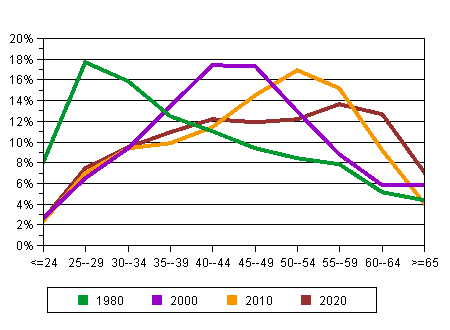 [D] [D]
Sources:
1980 and 2000 SSRN; NSM projections for
2010 and 2020.
1.
Workforce Participation
The
active RN supply is defined as the licensed
RN population who provides nursing services
or are seeking employment in nursing.
This supply estimate excludes RNs who
are licensed but not working in the nursing
field (e.g., retired RNs who retain a
license, RNs who have temporarily left
the workforce, and licensed RNs employed
in non-nursing positions). Responses to
the SSRN are subjective, with individual
respondents determining whether they are
employed in a nursing position. The NSM
applies national rates of workforce participation,
by RN age and education level, to the
projected licensed RN population in each
State to project active nurse supply (Exhibit
5).
In
a recent survey of approximately 7,300
licensed nurses (ANA, 2001), 672 respondents
Stated reasons for their decision not
to work in a nursing position. Approximately
25 percent found their current position
more rewarding professionally, 20 percent
cited better salaries in their current
position, 20 percent reported more convenient
work hours in their current position,
and 18 percent cited personal safety concerns
with working in a healthcare environment.
If these estimates represent the entire
licensed nurse workforce, then of the
approximately 136,000 licensed RNs in
2000 employed in non-nursing positions
(BHPr, 2001), an estimated:
-
34,000 would find their current position
more rewarding professionally,
-
27,000 would cite better salaries in
their current position,
-
27,000 would report more convenient
work hours in their current position,
and
-
24,000 would cite personal safety concerns
with working in a healthcare environment.
Only
70 percent of nurses in 2000 report being
satisfied in their current position, which
is significantly lower than U.S. workers
in general (85 percent) and professionals
in particular (90 percent) (BHPr, 2001).
Job satisfaction among RNs was lowest
in nursing homes and hospitals and highest
in nursing education. Thus, of the approximately
2.2 million RNs employed in nursing in
2000, an estimated 672,000 were dissatisfied
with their work.
The
NSM software contains algorithms that
allow users the potential to model changes
in workforce participation rates over
time based on projected changes in RN
compensation and working conditions. There
exists a paucity of research, however,
identifying appropriate measures of working
conditions and impact of changes in these
factors on RN workforce participation.
Exhibit
5. Workforce Participation Rates of Licensed
RNs, by Age and Highest Education Level
Attained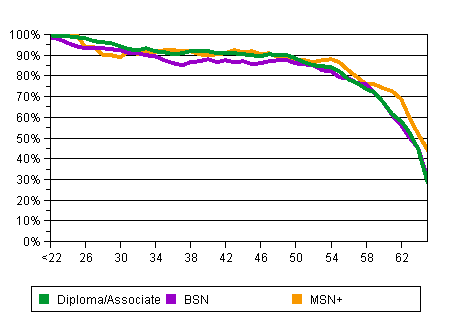 [D]
[D]
Source:
Analysis of the 2000 SSRN.
The
NSM also projects the FTE supply of RNs
by applying FTE workforce participation
rates that vary by RN age and education
level (Exhibit 6). The FTE supply counts
RNs working fulltime in nursing as one
FTE and RNs working part time as one-half
of an FTE.
Exhibit
6. FTE Workforce Participation Rates of
Licensed RNs, by Age and Highest Education
Level Attained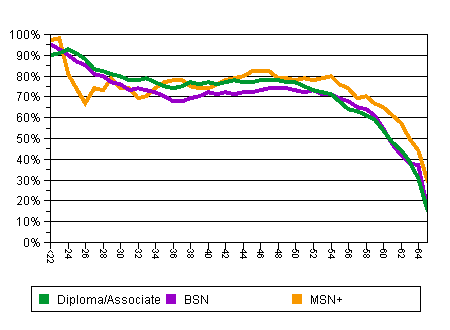 [D] [D]
Source:
Analysis of the 2000 SSRN.
2.
Cross-State Migration Patterns
Nurses
migrate between States for better career
opportunities, because of change in location
of spouses’ employment, and for many other
reasons. Some States are net exporters
of RNs (i.e., more RNs leave than enter
the State in a given year), while other
States are net importers. The NSM estimates
the number of RNs who will leave or enter
the State each year by applying migration
probabilities that vary by RN age, education
level, and State. We estimated these migration
probabilities by estimating a probit model
using data from the 1992, 1996, and 2000
SSRNs. The SSRN asks survey participants
in which State they resided at the time
of the survey and one year before the
survey. Nurses who change States between
the survey date and the preceding year
are identified as cross-State migrants.
The probit model estimates the probability
of leaving (or entering) a particular
State as a function of RN age, education
level, and State of residence. The NSM
first estimates the number of nurses leaving
each State by age and education level.
Then, the NSM allocates this pool of migrating
nurses to each State based on immigration
probabilities that vary by State, RN age,
and RN education level.
RNs
prepared at the masters level or higher
are more likely to migrate than are RNs
prepared at the baccalaureate level, who
in turn are more likely to migrate than
are RNs with a diploma or associate degree
(Exhibit 7). The analysis also shows significant
variation across States in migration patterns.
Younger RNs are more likely to migrate
across States than are older RNs, reflecting
factors such as greater transience among
professionals early in their career as
they seek employment after graduation.
Exhibit
7. Probability of Cross-State Migration,
by Age and Education Level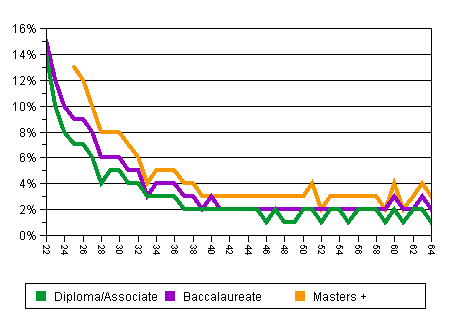 [D] [D]
Source:
Analysis of the 1992, 1996, and 2000 SSRNs.
Note:
Probability of immigration and emigration
varies by State.
3.
Change in Education Level Attained
Some
RNs will continue their schooling and
thus move to a higher education category
during the year. The NSM tracks two types
of education upgrades: RNs prepared at
the diploma or associate level who earn
a baccalaureate degree and RNs prepared
at the baccalaureate level who earn a
master’s or higher degree (Exhibit 8).
The probability that an RN will upgrade
his or her education level varies by age
and was estimated using a probit model
and data from the 1992, 1996, and 2000
SSRNs.
Exhibit
8. Percentage of RNs Who Upgrade Their
Education, by Age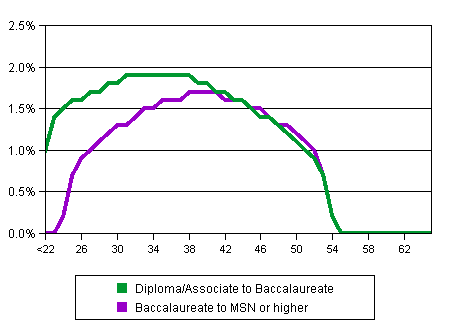 [D]
[D]
Source:
Analysis of the 1992, 1996, and 2000 SSRNs.
Note:
An analysis of the SSRN found that few
nurses age 55 and older upgrade their
education, and the drop in probability
of education upgrade for nurses in their
early 50s reflects this transition to
a zero probability.
C.
Permanent Separation from the Nurse Workforce
Reasons
why RNs permanently leave the workforce
and do not renew their license include
retirement, mortality, disability, and
other factors. The NSM contains one set
of attrition rates that combines all reasons
for failing to renew one’s license. These
rates do not, however, reflect temporary
departures from the nurse workforce captured
through the use of workforce participation
rates as described previously.
We
constructed separation rates (Exhibit
9) by combining mortality rates for women
obtained from Minino et al. (2002) and
estimated rates of attrition for reasons
of disability and retirement using data
from the 1998, 1999, 2000, and 2001 March
Current Population Survey (CPS). The CPS
collects data on respondent age, gender,
education level, and workforce participation.
These workforce departure rates were constructed
based on data for all U.S. college–educated
women. There exists a paucity of information
on workforce separation rates for RNs,
and, in particular, the number of RNs
who fail to renew their license after
changing careers. (The SSRN surveys only
nurses with an active license.) Anecdotal
evidence suggests that many RNs who leave
nursing retain their license even when
they have little intention of returning
to nursing. We account for nurses who
change careers but continue to renew their
license in our workforce participation
and FTE supply rates.
Exhibit
9. Workforce Separation Rates for College-Educated
Women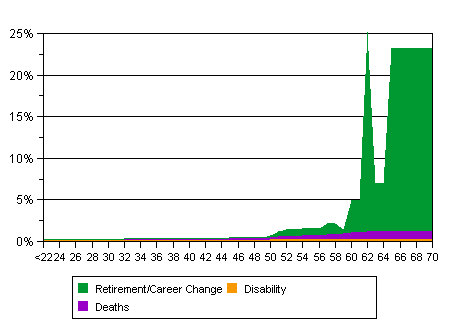 [D] [D]
Source:
Analysis of the 1998–2001 CPS files; mortality
rates from Minino et al. (2002).
D.
Nursing Supply Projections
Below
we present projections from the NSM. The
baseline projections assume the status
quo, while projections for three alternative
scenarios illustrate the supply implications
of increasing the number of graduating
RNs, increasing RN wages, and improving
RN retention in the workforce.
1.
Baseline Projections
The
NSM baseline projections reflect the level
of RN supply most likely to occur if current
trends continue (Exhibit 10). At the national
level, the number of licensed RNs is projected
to remain relatively constant at about
2.7 million nurses between 2000 and 2020.
The number of licensed RNs is projected
to increase slightly through 2012 but
to start declining as the number of retiring
RNs exceeds the number of new graduates.
The number of RNs active in nursing is
projected to remain between 2.1 million
and 2.3 million during this period, while
the FTE supply of RNs is projected to
decrease slightly from 1.89 million in
2000 to 1.81 million in 2020. At the State
level, substantial variation occurs in
the growth (or decline) of the RN population
between 2000 and 2020 based on the number
of new RN graduates in each State, net
cross-State migration, and attrition from
the RN population.
Exhibit
10. Baseline RN Projections, 2000 to 2020
| |
2000 |
2005 |
2010 |
2015 |
2020 |
Change
from 2000–2020 |
| Licensed
RNs |
2,697,000 |
2,752,000 |
2,795,000 |
2,781,000 |
2,705,000 |
0% |
| RNs
providing nursing services or seeking
employment in nursing |
2,249,000
|
2,303,000
|
2,305,000
|
2,250,000
|
2,163,000
|
-4% |
| FTE
RNs providing nursing services |
1,891,000 |
1,943,000 |
1,941,000 |
1,886,000 |
1,808,000 |
-4% |
To
assess the sensitivity of the model to
key determinants of RN supply, we projected
supply under alternative scenarios where
we vary key assumptions.
2. Scenario 1:
Change in Output from Nursing Programs
Under
the baseline projections, the year-to-year
percentage change in the number of graduates
from nursing programs in each State is
directly proportional to percentage change
in size of the State’s female population
ages 20 to 44 (which, as discussed previously,
is used as a proxy for the size of the
pool of nursing school candidates). The
NSM uses State-level estimates of new
RN graduates in 2000 as the starting point
for the projections. Projections of the
FTE RN supply increase substantially over
time under alternative scenarios where
the number of graduates from U.S. nursing
programs, relative to the baseline projections,
is 30 percent higher, 60 percent higher,
and 90 percent higher year after year
(Exhibit 11). Over time, the difference
in projected total FTE RNs between each
scenario grows such that by 2020 the difference
in totals FTE RNs, relative to the baseline
projections, is +314,000, +628,000, and
+929,000 for, respectively, the +30 percent,
+60 percent, and +90 percent scenarios.
To meet projected growth in demand
for RN services, the U.S. must graduate
approximately 90 percent more nurses from
U.S. nursing programs relative to the
baseline graduate projections.
Exhibit
11. FTE Supply Implications of Changes
in Projected Number of New Graduates from
U.S. Nursing Programs [3]
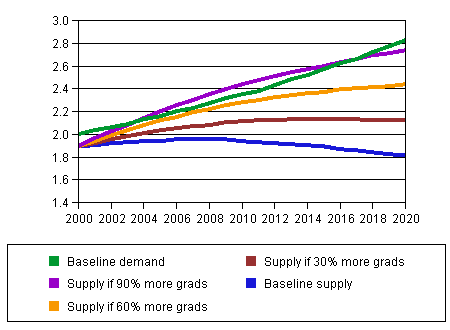 [D] [D]
3.
Scenario 2: Change in RN Wages
If
wages for nursing services increase relative
to wages in alternative occupations, then,
all else being equal, nursing becomes
a more attractive career. In the short
run, an increase in wages for nursing
services would increase the FTE RN supply
by motivating:
-
Licensed RNs not practicing nursing
to return to nursing,
-
Part-time RNs to work more hours, and
-
RNs to delay retirement or leave retirement.
The
short-term percentage increase in FTE
RN supply attributed to each 1 percent
increase in wages for nursing services
is referred to as short-term wage elasticity
of supply.
In
the long run, an increase in wages for
nursing services will also attract new
entrants to the nursing workforce (assuming
no constraints on nursing school capacity).
Because of the time to recognize an increase
in RN wages and the time to train new
nurses, a delay of several years is expected
between the time that RN wages increase
and new entrants to the nursing profession
increase. The long-term wage elasticity
of supply, consequently, is larger
than the short-term wage elasticity of
supply.
There
exists a paucity of research that estimates
the wage elasticity of supply for nurses,
and the few studies that have been published
report a large range of elasticity estimates.
One challenge when assessing the validity
of these estimates for modeling the supply
of RNs is to distinguish between short-term
and long-term wage elasticities and to
distinguish between market wage elasticities
and wage elasticities specific to a particular
provider (e.g., if one hospital increases
RN wages, then that hospital will draw
nurses away from other hospitals). Sloan
and Richupan (1975) obtained wage elasticity
estimates for RN workforce participation
that ranged from 0.18 to 2.82. Using a
sample of Norwegian nurses, Askildsen
et al. (2002) estimate wage elasticities
for workforce participation ranging from
0.253 to 0.843. For comparison, a review
of the literature assessing the military’s
ability to recruit finds most pay elasticity
estimates in the 0.5 to 1.5 range (Hogan
et al., 1995).
For
this scenario, we assume annual growth
in RN wages, relative to wage growth in
alternative occupations, of 0 percent
(the assumption in the baseline projections),
+1 percent, +2 percent, and +3 percent
annually between 2000 and 2020 [4]
(Exhibit 12). The wage growth rates have
a compounding effect over time, so a 1
percent growth rate over a 20-year period
means that by 2020 RN wages would have
increased, relative to other occupations,
by 22 percent. We assume that each 1 percent
increase in wages increases the number
of RN graduates by 0.8 percent and increases
workforce participation rates by 0.3 percent.
By 2020, relative to the baseline projections,
the number of FTE RNs is +228,000 (+13
percent), +518,000 (+29 percent), and
+886,000 (+49 percent), respectively,
for the scenarios with 1 percent, 2 percent,
and 3 percent annual growth in real wages.
The
baseline demand projections, discussed
in more detail later, assume that RN wages
will grow at the same rate as wages of
licensed practical nurses (LPN) and other
healthcare occupations. If RN wages were
to rise faster than, say, LPNs, then employers
of nurses would have a financial incentive
to substitute lower-cost LPNs for higher-cost
RNs, where feasible. Spetz and Given (2003)
estimate that inflation-adjusted wages
must increase by between 3 percent and
4 percent per year between 2002 and 2016
to bring RN labor markets into equilibrium.
Assuming each 1 percent real increase
in RN wages increases the number of new
RN graduates by 0.8 percent and increases
FTE activity rates by 0.3 percent, a continuous
3 percent annual increase in RN wages
would still result in a shortfall of approximately
100,000 FTE RNs but would prevent the
shortage from growing more severe (Exhibit
13).
Exhibit
12. Supply Implications of Rising RN Wages,
2020
|
|
Annual
Wage Growth (relative to annual
wage growth in alternative professions) |
|
0%
(Baseline) |
1% |
2% |
3% |
|
Cumulative
wage growth 2000–2020 |
0% |
22% |
49% |
81% |
|
Graduates/year
2020
(percentage
different from baseline) |
72,400 |
85,500
+18% |
102,000
+40% |
121,000
+67% |
|
Licensed
RNs 2020
(percentage
different from baseline) |
2,704,000 |
2,827,000
+5% |
2,969,000
+10% |
3,130,000
+16% |
|
FTE
RNs 2020
(percentage
different from baseline) |
1,808,000 |
2,036,000
+13% |
2,326,000
+29% |
2,694,000
+49% |
|
FTE
Rate 2020 (aggregate) |
67% |
72% |
78% |
86% |
Exhibit
13. Projected FTE RN Supply under Alternative
Wage Growth Scenarios
 [D] [D]
Note:
Projections assume wage elasticities of
0.8 for new graduates and 0.3 for FTE
workforce participation rates.
4.
Scenario 3: Change in RN Retirement Patterns
The
rate at which RNs permanently separate
from the RN workforce varies by age and
education level, with high rates of departure
between age 62 and age 65 as nurses qualify
for Social Security and Medicare benefits.
Using the NSM, we project RN supply if
each RN were to work an additional 4 years
before retiring. Delays in average retirement
age might occur as a result of (1) government
policies delaying eligibility for Social
Security and Medicare, (2) a healthier
population able to remain longer in the
workforce, or (3) improvements to RN working
conditions that increase the likelihood
that nurses will remain active in the
workforce. Compared to the baseline projections,
delaying retirement by an average of 4
years would increase the FTE RN supply
by nearly 158,000 (9 percent) in 2020.
Still, such an increase exerts only a
modest effect on alleviating the projected
growing RN shortage (Exhibit 14).
Exhibit
14. Impact of Changing Retirement Patterns
on FTE RN Supply
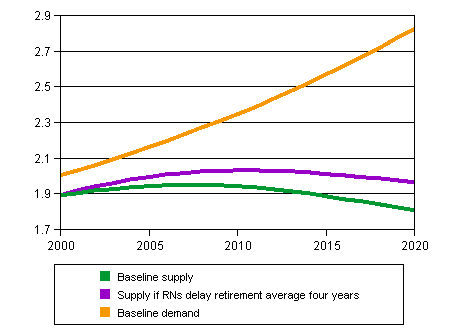 [D] [D]
|